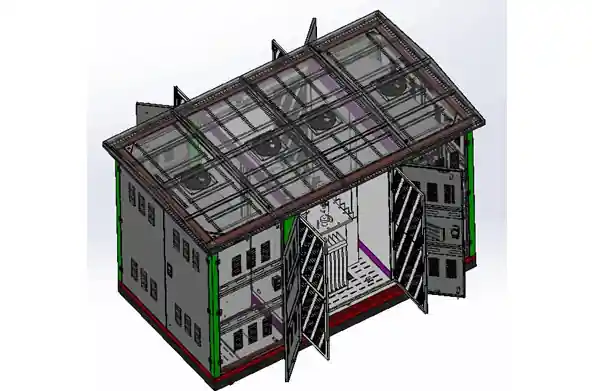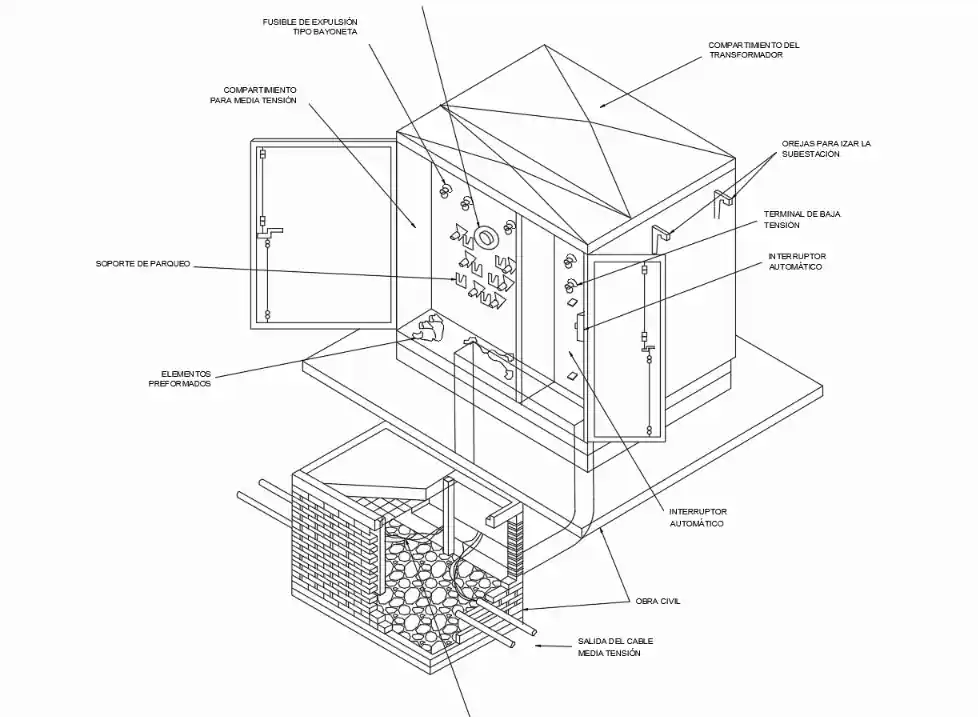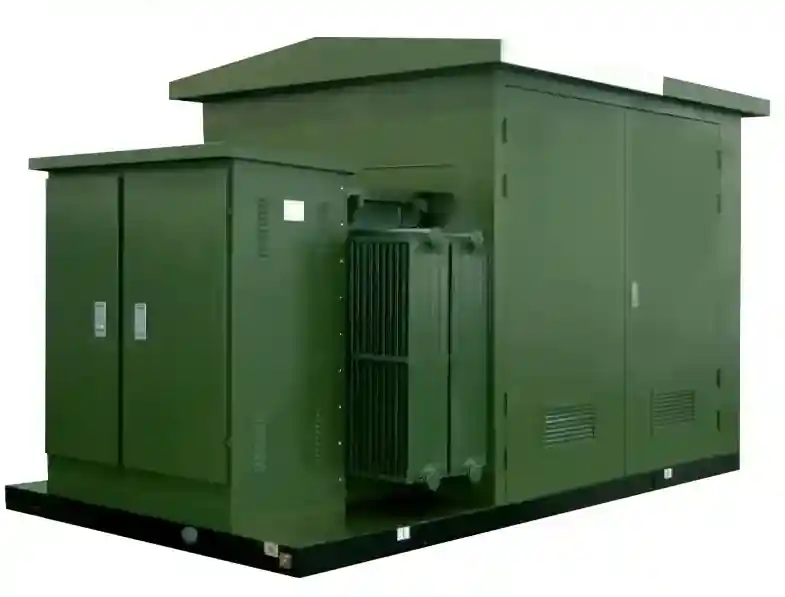
Základní koncept: Co je kompaktní rozvodna?
A kompaktní rozvodna integruje rozváděč středního napětí, transformátor a rozváděč nízkého napětí do jednoho uzavřeného celku. Jeho hlavní funkcí je snižovat střední napětí (obvykle 11 kV, 22 kV nebo 33 kV) na nízké napětí (obvykle 400 V) použitelné pro koncové uživatele.
Kompaktní rozvodny jsou sestaveny z výroby, otestovány a připraveny k rychlému nasazení, takže jsou ideální pro městské a průmyslové prostředí a prostředí s obnovitelnými zdroji energie.
Podle Wikipedia, jsou tyto rozvodny nezbytné pro oblasti, kde je rozhodující prostor, bezpečnost a estetika.
Typické hodnoty kompaktních rozvoden
| Parametr | Typický rozsah |
|---|---|
| Jmenovité napětí (strana VN) | 3,3 kV, 6,6 kV, 11 kV, 22 kV, 33 kV |
| Jmenovité napětí (strana NN) | 400V, 690V |
| Jmenovitý výkon | 100 kVA až 3150 kVA |
| Frekvence | 50Hz / 60Hz |
| Zkratový výdržný proud | Až 31,5 kA (strana VN) |
| Třída ochrany | IP23 až IP54 |
| Metoda chlazení | ONAN (Oil Natural Air Natural) pro transformátory |

Aplikační pole
- Městské rezidenční stavby: Distribuce nízkého napětí do bytů a komerčních komplexů.
- Průmyslové parky: Napájení těžkých strojů, systémů HVAC a výrobních linek.
- Zařízení na výrobu energie z obnovitelných zdrojů: Používá se ve větrných elektrárnách a solárních parcích k připojení výroby energie k distribučním sítím.
- Datová centra: Zajišťuje bezpečnou a nepřerušovanou transformaci středního napětí na nízké napětí.
- Dopravní systémy: železniční stanice a letištní zařízení.
Zpráva IEEE Spectrum zdůrazňuje rostoucí poptávku po kompaktních rozvodnách v distribuovaných výrobních a městských energetických sítích.
Trendy na trhu a technologický vývoj
- Modularizace: Výrobci jako např. ABB, Siemensa Schneider Electric nyní nabízí vysoce modulární konstrukce pro rychlejší přizpůsobení.
- Ekologicky šetrné materiály: Zavedení biologicky odbouratelných transformátorových olejů a recyklovatelných materiálů krytů.
- Chytré monitorování: Integrace systémů SCADA a senzorů IoT pro sledování výkonu v reálném čase.
- Vyšší hodnocení IP: Zvýšená ochrana proti prachu a vodě pro venkovní instalace nebo instalace v náročných podmínkách.
Vysvětlení technických parametrů
Jmenovitý výkon: Označuje maximální trvalé zatížení, které rozvodna zvládne bez přehřátí. Běžné jednotky se pohybují v rozmezí od 100 kVA pro malé systémy až po 3150 kVA pro velké průmyslové nebo komunální instalace.
Jmenovité napětí: Určuje vstupní (střední napětí) a výstupní (nízké napětí) úroveň. Správné přizpůsobení napětí je rozhodující pro stabilitu systému.
Zkratový proud: Udává schopnost přežít náhlé poruchy s vysokým proudem bez katastrofického selhání.

Rozdíly oproti tradičním rozvodnám
| Aspekt | Tradiční rozvodna | Kompaktní rozvodna |
| Doba instalace | Několik měsíců | Několik týdnů |
| Požadavek na prostor | Vysoká | Minimální |
| Náklady | Vyšší počáteční náklady | Nižší celkové náklady pro potřeby středního rozsahu |
| Přizpůsobení | Vysoká | K dispozici jsou modulární možnosti |
| Mobilita | Obtížné | Relativně snadné |
Kompaktní rozvodny překlenují rozdíl mezi flexibilitou a výkonem, zejména tam, kde je omezený prostor nebo kde je vyžadováno rychlé nasazení.
Tipy pro nákup a pokyny pro výběr
- Definujte požadavky na zatížení: Pečlivě odhadněte současné a budoucí profily zatížení.
- Zvažte podmínky prostředí: Zvolte odpovídající stupeň krytí IP pro venkovní, pobřežní nebo průmyslové prostředí.
- Vyhodnoťte typ transformátoru: Olejové a suché v závislosti na riziku požáru a možnostech údržby.
- Plán rozšíření: Vybírejte jednotky s prostorem pro růst zátěže nebo paralelní operace.
- Zkontrolujte certifikace: Hledejte shodu s normami IEC 62271-202, IEEE C37.20.2 nebo ekvivalentními normami.
Konzultace se zkušenými výrobci nebo firmami EPC zajišťuje optimální řešení přizpůsobená specifickým požadavkům projektu.
Často kladené otázky (FAQ)
A1: Pod pojmem kiosková rozvodna se obvykle rozumí kompaktní rozvodna se specifickou konstrukcí skříně, často menší a určená pro městské sítě. Funkčně jsou si obě podobné, ale liší se konstrukcí a velikostí.
A2: Ano. Jsou ideální pro solární farmy, větrné parky a mikrosítě díky své modularitě, rychlému nasazení a kompatibilitě s decentralizovanými zdroji energie.
A3: Při správné údržbě může kompaktní rozvodna spolehlivě fungovat 25-40 let v závislosti na podmínkách prostředí a faktorech zatížení.
Kompaktní rozvodny mají zásadní význam pro zajištění spolehlivé, účinné a flexibilní distribuce elektrické energie. Pochopení jejich hodnocení zajišťuje optimální návrh a realizaci v širokém spektru moderních infrastrukturních projektů.


